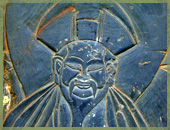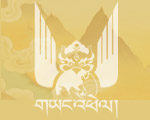 By
the 17th century Buddhism was consolidated as the dominant religion
for the region, applying some degree of coherence to an otherwise
disjointed setting. Political organization remained localized,
an assortment of respective nobilities, clans and territories.
The abilities for conquests, expansions and incorporations were
significantly constrained by geographic inaccessibility and
firm resident allegiances. In the west, five Drukpa families
were firmly established. The central areas were controlled by
a collection of older ruling families and more recent Nyingmapa
nobilities. Power in the east remained the most dislocated,
a myriad of small independent units ruled by their respective
clan representatives. The majority traced their descent to Prince
Tsangma of the Tibetan royal family, who is said to have come
to eastern Bhutan in the ninth century. By
the 17th century Buddhism was consolidated as the dominant religion
for the region, applying some degree of coherence to an otherwise
disjointed setting. Political organization remained localized,
an assortment of respective nobilities, clans and territories.
The abilities for conquests, expansions and incorporations were
significantly constrained by geographic inaccessibility and
firm resident allegiances. In the west, five Drukpa families
were firmly established. The central areas were controlled by
a collection of older ruling families and more recent Nyingmapa
nobilities. Power in the east remained the most dislocated,
a myriad of small independent units ruled by their respective
clan representatives. The majority traced their descent to Prince
Tsangma of the Tibetan royal family, who is said to have come
to eastern Bhutan in the ninth century.
The major turning point occurred in the 17th century under
the extraordinary leadership of the Shabdrung Ngawang Namgyal.
Born in Tibet in 1594, he hailed from the princely family
of Gya, which was then head of the Drukpa Kagyupa order. He
was recognized as the reincarnation of the great Drukpa scholar
Pema Karpo (1527-1592) - himself the incarnation of Tsangpa
Gyare Yeshe Dorje (1161-1211), the founder of the Drukpa Kagyupa
branch - and was groomed as a potential successor to the Drukpa
throne. In 1606 he succeeded his late grandfather as the 18th
prince-abbot of the Drukpas. However, he became embroiled
in a dispute over his status as Pema Karpo's reincarnation,
most notably with the powerful provincial ruler, the Tsang
Desi. Under considerable danger at Ralung and having received
an invitation from the Obtsho Lama of Gasa in northwestern
Bhutan, in 1616, at the age of twenty-three, he left with
his entourage carrying important relics of the Drukpa school.
Upon arrival the controlling Drukpa families of the west,
who revered him as the true Drukpa hierarch, welcomed the
future Shabdrung. Thus began the long and complex process
of western and subsequently national unification. He united
the Drukpa families under his authority, traveled extensively
in western Bhutan, and through his ongoing exploits propagated
increasing prestige and political influence. The principal
threats to his increasing authority came externally from Tibet,
initially from the Tsang Desi and later from the controlling
Gelugpa School, and internally from a coalition of the other
religious schools in the region called the "five groups
of lamas". The first half of the century was a period
of political consolidation as allies were courted and enemies
repelled. Tibetan invasions were resisted shortly after his
arrival, and again in 1634 and 1639 supported by the five
groups of lamas. Two further Tibetan offensives were overcome
in 1644 and 1648/9. By the time of his death in 1651 the Shabdrung,
an honorific title meaning "at whose feet one submits",
had unified western Bhutan, vanquished competing religious
schools and fought off five Tibetan invasions.
In 1651 the Shabdrung entered strict seclusion in the Punakha
Dzong, never to reappear. His death remained concealed for
another fifty years, thereby aiding in the further consolidation
of his legacy. By 1656 central and eastern Bhutan had been
brought under Drukpa political rule, thus concluding the process
of internal integration and heralding the birth of the nation.
The Shabdrung left a major legacy to Drukyul, the land that
bears the name of his religious school. Aside from being the
dominant force behind unification, he was to pass on another
fundamental bequest: a legal, political, administrative and
physical infrastructure. One of his notable achievements was
the creation of a formal code of laws for the country, called
the Katrim. The Katrim defined the spiritual, economic and
judicial relationships between state and society. In return
for the teachings, initiations and rituals performed by the
monastic community for the benefit of individual, society
and nation, subjects were responsible for material and financial
support, which took the form of various taxes. Written along
Buddhist lines, the code further regulated all aspects of
social life, from the nature of crime and punishment, to the
behavior of monks and officials and the use of tobacco.
Prior to entering retreat, the Shabdrung sought to establish
a strong government to administer after his death. The Shabdrung
(and his subsequent incarnations) was recognized as the head
of a theocratic Drukpa Kagyupa state. Under him was founded
a dual system of government, known as chosi, where the monk
body and associated religious matters were controlled by a
chief abbot, the Je Khenpo, and political affairs were directed
by a temporal head, the desi. The country was divided into
three regions, each under the authority of a governor or ponlop.
Other important posts were the chief of the dzong (dzongpon)
and the elders (gups), who looked after several villages and
mediated between state and society. Dzongs, monastic fortresses,
formed the physical core for political, religious, administrative
and legal systems. During his life the Shabdrung built a dzong
in each valley in western Bhutan, thereby cementing his authority
over the land, a process that was continued into the central
and eastern regions. These dzongs, which were the seat for
both religious and administrative power, are unique to Bhutan,
and remain perhaps the most overt and enduring symbols of
the Drukpa theocracy and the Shabdrung himself.
|



